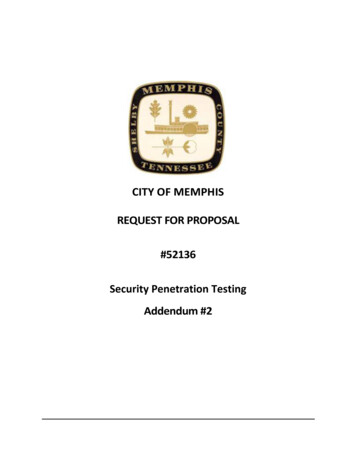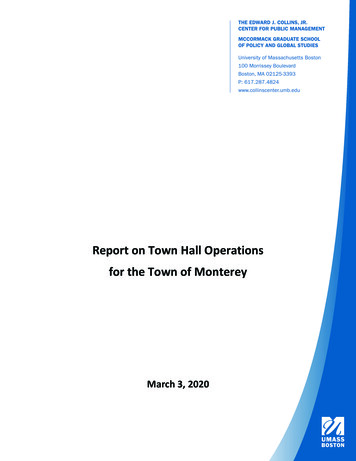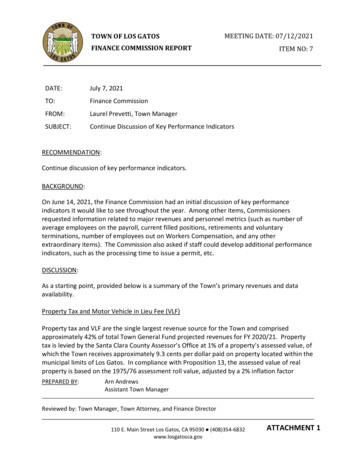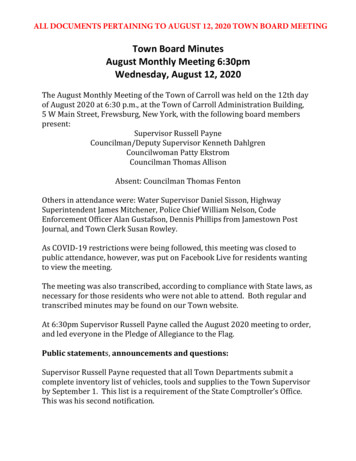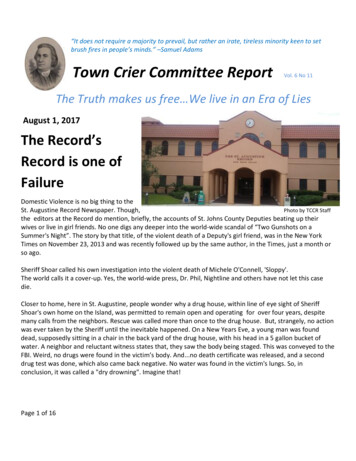
Transcription
Town Crier:An Authenticated Data Feed for Smart ContractsFan Zhang1,3Ethan Cecchetti1,3Kyle ufanz@cs.cornell.eduAri Juels2,3Elaine Shi1,3juels@cornell.edurs2358@cornell.edu1Cornell University 2 Cornell Tech, Jacobs Institute 3 Initiative for CryptoCurrencies and ContractsABSTRACTSmart contracts are programs that execute autonomouslyon blockchains. Their key envisioned uses (e.g. financial instruments) require them to consume data from outside theblockchain (e.g. stock quotes). Trustworthy data feeds thatsupport a broad range of data requests will thus be criticalto smart contract ecosystems.We present an authenticated data feed system called TownCrier (TC). TC acts as a bridge between smart contracts andexisting web sites, which are already commonly trusted fornon-blockchain applications. It combines a blockchain frontend with a trusted hardware back end to scrape HTTPSenabled websites and serve source-authenticated data to relying smart contracts.TC also supports confidentiality. It enables private datarequests with encrypted parameters. Additionally, in a generalization that executes smart-contract logic within TC,the system permits secure use of user credentials to scrapeaccess-controlled online data sources.We describe TC’s design principles and architecture andreport on an implementation that uses Intel’s recently introduced Software Guard Extensions (SGX) to furnish data tothe Ethereum smart contract system. We formally model TCand define and prove its basic security properties in the Universal Composability (UC) framework. Our results includedefinitions and techniques of general interest relating to resource consumption (Ethereum’s “gas” fee system) and TCBminimization. We also report on experiments with three example applications.We plan to launch TC soon as an online public service.1.INTRODUCTIONSmart contracts are computer programs that autonomouslyexecute the terms of a contract. For decades they have beenenvisioned as a way to render legal agreements more precise,pervasive, and efficiently executable. Szabo, who popularized the term “smart contract” in a seminal 1994 essay [36],gave as an example a smart contract that enforces car loanpayments. If the owner of the car fails to make a timelypayment, a smart contract could programmatically revokephysical access and return control of the car to the bank.Cryptocurrencies such as Bitcoin [30] provide key technical underpinnings for smart contracts: direct control ofmoney by programs and fair, automated code execution throughthe decentralized consensus mechanisms underlying blockchains.The recently launched Ethereum [14, 38] supports Turing-complete code and thus fully expressive self-enforcing decentralized smart contracts—a big step toward the vision ofresearchers and proponents. As Szabo’s example shows, however, the most compelling applications of smart contracts—such as financial instruments—additionally require access todata about real-world state and events.Data feeds (also known as “oracles”) aim to meet this need.Very simply, data feeds are contracts on the blockchain thatserve data requests by other contracts [14, 38]. A few datafeeds exist for Ethereum today that source data from trustworthy websites, but provide no assurance of correctly relaying such data beyond the reputation of their operators(typically individuals or small entities). HTTPS connectionto a trustworthy website would seem to offer a solution, butsmart contracts lack network access, and HTTPS does notdigitally sign data for out-of-band verification. The lack of asubstantive ecosystem of trustworthy data feeds is frequentlycited as critical obstacle to the evolution of Ethereum anddecentralized smart contracts in general [21].Town Crier. We introduce a system called Town Crier(TC) that addresses this challenge by providing an authenticated data feed (ADF) for smart contracts. TC acts as a hightrust bridge between existing HTTPS-enabled data websitesand the Ethereum blockchain. It retrieves website data andserves it to relying contracts on the blockchain as concisepieces of data (e.g. stock quotes) called datagrams. TC usesa novel combination of Software Guard Extensions (SGX),Intel’s recently released trusted hardware capability, and asmart-contract front end. It executes its core functionalityas a trusted piece of code in an SGX enclave, which protects against malicious processes and the OS and can attest(prove) to a remote client that the client is interacting witha legitimate, SGX-backed instance of the TC code.The smart-contract front end of Town Crier responds torequests by contracts on the blockchain with attestations ofthe following form:“Datagram X specified by parameters params is servedby an HTTPS-enabled website Y during a specified timeframe T .”A relying contract can verify the correctness of X in such adatagram assuming trust only in the security of SGX, the(published) TC code, and the validity of source data in thespecified interval of time.Another critical barrier to smart contract adoption is thelack of confidentiality in today’s ecosystems; all blockchainstate is publicly visible, and existing data feeds publicly
expose requests. TC provides confidentiality by supportingprivate datagram requests, in which the parameters are encrypted under a TC public key for ingestion in TC’s SGXenclave and are therefore concealed on the blockchain. TCalso supports custom datagram requests, which securely access the online resources of requesters (e.g. online accounts)by ingesting encrypted user credentials, permitting TC tosecurely retrieve access-controlled data.We designed and implemented TC as a complete, highlyscalable, end-to-end system that offers formal security guarantees at the cryptographic protocol level. TC runs on real,SGX-enabled host, as opposed to an emulator (e.g. [10, 33]).We plan to launch a version of TC as an open-source, production service atop Ethereum, pending the near-future availability of the Intel Attestation Service (IAS), which is neededto verify SGX attestations.Technical challenges. Smart contracts execute in an adversarial environment where parties can reap financial gainsby subverting the contracts or services on which they rely.Formal security is thus vitally important. We adopt a rigorous approach to the design of Town Crier by modelingit in the Universal Composability (UC) framework, building on [28, 35] to achieve an interesting formal model thatspans a blockchain and trusted hardware. We formally define and prove that TC achieves the basic property of datagram authenticity—informally that TC faithfully relays current data from a target website. We additionally prove fairexpenditure for an honest requester, informally that the feepaid by a user contract calling TC is at most a small amountto cover the operating costs of the TC service, even if theTC host is malicious.Another contribution of our work is introducing and showing how to achieve two key security properties: gas sustainability and trusted computing base (TCB) code minimizationwithin a new TCB model created by TC’s combination of ablockchain with SGX.Because of the high resource costs of decentralized codeexecution and risk of application-layer denial-of-service (DoS)attacks, Ethereum includes an accounting resource calledgas to pay for execution costs. Informally, gas sustainabilitymeans that an Ethereum service never runs out of gas, a general and fundamental availability property. We give a formaldefinition of gas sustainability applicable to any Ethereumservice, and prove that TC satisfies it.We believe that the combination of blockchains with SGXintroduced in our work will prove to be a powerful and general way to achieve confidentiality in smart contract systems and network them with off-chain systems. This newsecurity paradigm, however, introduces a hybridized TCBthat spans components with different trust models. We introduce techniques for using such a hybridized TCB securely while minimizing the TCB code size. In TC, we showhow to avoid constructing an authenticated channel fromthe blockchain to the enclave—bloating the enclave withan Ethereum client—by instead authenticating enclave outputs on the blockchain. We also show how to minimize onchain signature-verification code. These techniques are general; they apply to any use of a similar hybridized TCB.Other interesting smaller challenges arise in the design ofTC. One is deployment of TLS in an enclave. Enclaves lacknetworking capabilities, so TLS code must be carefully partitioned between the enclave and untrusted host environment.Another is hedging in TC against the risk of compromise ofa website or single SGX instance, which we accomplish withvarious modes of majority voting: among multiple websitesoffering the same piece of data (e.g. stock price) or amongmultiple SGX platforms.Applications and performance. We believe that TC canspur deployment of a rich spectrum of smart contracts thatare hard to realize in the existing Ethereum ecosystem. Weexplore three examples that demonstrate TC’s capabilities:(1) A financial derivative (cash-settled put option) that consumes stock ticker data; (2) A flight insurance contract thatrelies on private data requests about flight cancellations; and(3) A contract for sale of virtual goods and online games (viaSteam Marketplace) for Ether, the Ethereum currency, usingcustom data requests to access user accounts.Our experiments with these three applications show thatTC is highly scalable. Running on just a single SGX host,TC achieves throughputs of 15-65 tx/sec. TC is easily parallelized across many hosts, as separate TC hosts can serve requests with no interdependency. (For comparison, Ethereumhandles less than 1 tx/sec today and recent work [19] suggests that Bitcoin can scale safely to no more 26 tx/secwith reparametrization.) For these same applications, experimental response times for datagram requests range from192-1309 ms—much less than an Ethereum block interval(12 seconds on average). These results suggest that a fewSGX-enabled hosts can support TC data feed rates well beyond the global transaction rate of a modern decentralizedblockchain.Contributions. We offer the following contributions: We introduce and report on an end-to-end implementation of Town Crier, an authenticated data feed systemthat addresses critical barriers to the adoption of decentralized smart contracts. TC combines a smart-contractfront end in Ethereum and an SGX-based trusted hardware back end to: (1) Serve authenticated data to smartcontracts without a trusted service operator and (2) Support private and custom data requests, enabling encryptedrequests and secure use of access-controlled, off-chaindata sources. We plan to launch a version of TC soonas an open-source service. We formally analyze the security of TC within the Universal Composability (UC) framework, defining functionalities to represent both on-chain and off-chain components. We formally define and prove the basic propertiesof datagram authenticity and fair expenditure as well asgas sustainability, a fundamental availability property forany Ethereum service. We introduce a hybridized TCB spanning the blockchainand an SGX enclave, a powerful new paradigm of trustworthy system composition. We present generic techniques that help shrink the TCB code size within thismodel as well as techniques to hedge against individualSGX platform compromises. We explore three TC applications that show TC’s ability to support a rich range of services well beyond thosein Ethereum today. Experiments with these applicationsalso show that TC can easily meet the latency and throughput requirements of modern decentralized blockchains.Due to space constraints, a number of details on formalism, proofs, implementation, and applications are relegatedto the paper appendices with pointers in the paper body.
Appendices may be found in the supplementary materials.2.BACKGROUNDIn this section, we provide basic background on the maintechnologies TC incorporates, namely SGX, TLS / HTTPS,and smart contracts.SGX. Intel’s Software Guard Extensions (SGX) [8, 22, 29,31] is a set of new instructions that confer hardware protections on user-level code. SGX enables process execution ina protected address space known as an enclave. The enclaveprotects the confidentiality and integrity of the process fromcertain forms of hardware attack and other software on thesame host, including the operating system.An enclave process cannot make system calls, but can readand write memory outside the enclave region. Thus isolatedexecution in SGX may be viewed in terms of an ideal modelin which a process is guaranteed to execute correctly andwith perfect confidentiality, but relies on a (potentially malicious) operating system for network and file-system access.1SGX allows a remote system to verify the software in anenclave and communicate securely with it. When an enclaveis created, the CPU produces a hash of its initial state knownas a measurement. The software in the enclave may, at alater time, request a report which includes a measurementand supplementary data provided by the process, such as apublic key. The report is digitally signed using a hardwareprotected key to produce a proof that the measured softwareis running in an SGX-protected enclave. This proof, knownas a quote, can be verified by a remote system, while theprocess-provided public key can be used by the remote system to establish a secure channel with the enclave or verifysigned data it emits. We use the generic term attestation torefer to a quote, and denote it by att. We assume that atrustworthy measurement of the code for the enclave component of TC is available to any client that wishes to verifyan attestation. SGX signs quotes using a group signaturescheme called EPID [12]. This choice of primitive is significant in our design of Town Crier, as EPID is a proprietarysignature scheme not supported natively in Ethereum. SGXadditionally provides a trusted time source via the functionsgx get trusted time. On invoking this function, an enclave obtains a measure of time relative to a reference pointindexed by a nonce. A reference point remains stable, butSGX does not provide a source of absolute or wall-clock time,another limitation we must work around in TC.TLS / HTTPS. We assume basic familiarity by readerswith TLS and HTTPS (HTTP over TLS). As we explainlater, TC exploits an important feature of HTTPS, namelythat it can be partitioned into interoperable layers: an HTTPlayer interacting with web servers, a TLS layer handlinghandshakes and secure communication, and a TCP layerproviding reliable data stream.Smart contracts. While TC can in principle support anysmart-contract system, we focus in this paper on its use inEthereum, whose model we now explain. For further details,see [14, 38].1This model is a simplification: SGX is known to exposesome internal enclave state to the OS [18]. Our basic securitymodel for TC assumes ideal isolated execution, but again,TC can also be distributed across multiple SGX instancesas a hedge against compromise.A smart contract in Ethereum is represented as what iscalled a contract account, endowed with code, a currencybalance, and persistent memory in the form of a key/valuestore. A contract accepts messages as inputs to any of a number of designated functions. These entry points, determinedby the contract creator, represent the API of the contract.Once created, a contract executes autonomously; it persistsindefinitely with even its creator unable to modify its code.2Contract code executes in response to receipt of a messagefrom another contract or a transaction from a non-contract(externally owned ) account, informally what we call a wallet. Thus, contract execution is always initiated by a transaction. Informally, a contract only executes when “poked,”and poking progresses through a sequence of entry pointsuntil no further message passing occurs (or a shortfall in gasoccurs, as explained below). The “poking” model aside, as asimple abstraction, a smart contract may be viewed as anautonomous agent on the blockchain.Ethereum has its own associated cryptocurrency calledEther. (At the time of writing, 1 Ether has a market valueof just under 15 U.S. [1].) To prevent DoS attacks, prevent inadvertent infinite looping within contracts, and generally control network resource expenditure, Ethereum allowsEther-based purchase of a resource called gas to power contracts. Every operation, including sending data, executingcomputation, and storing data, has a fixed gas cost. Transactions include a parameter (GASLIMIT) specifying a boundon the amount of gas expended by the computations theyinitiate. When a function calls another function, it may optionally specify a lower GASLIMIT for the child call whichexpends gas from the same pool as the parent. Should afunction fail to complete due to a gas shortfall, it is abortedand any state changes induced by the partial computationare rolled back to their pre-call state; previous computationson the call path, though, are retained and gas is still spent.Along with a GASLIMIT, a transaction specifies a GASPRICE,the maximum amount in Ether that the transaction is willing to pay per unit of gas. The transaction thus succeedsonly if the initiating account has a balance of GASLIMIT GASPRICE Ether and GASPRICE is high enough to be acceptedby the system (miner).As we discuss in Section 5.1, the management of gas iscritical to the availability of TC (and other Ethereum-basedservices) in the face of malicious users.Finally, we note that transactions in Ethereum are digitally signed for a wallet using ECDSA on the curve Secp256k1and the hash function SHA3-256.3.ARCHITECTURE AND SECURITY MODELTown Crier includes three main components: The TC Contract (CTC ), the Enclave (whose code is denoted by progencl ),and the Relay (R). The Enclave and Relay reside on the TCserver, while the TC Contract resides on the blockchain. Werefer to a smart contract making use of the Town Crier service as a requester or relying contract, which we denote CU ,and its (off-chain) owner as a client or user. A data source, orsource for short, is an online server (running HTTPS) thatprovides data which TC draws on to compose datagrams.An architectural schematic of TC showing its interactionwith external entities is given in Figure 1.2There is one exception: a special opcode suicide wipescode from a contract account.
BlockchainTC ServerTC ContractCTCRelayRData SourceHTTPSlots-odata.comUser ContractCUEnclave(progencl )Figure 1: Basic Town Crier architecture. Trustedcomponents are depicted in green.The TC Contract CTC . The TC Contract is a smart contract that acts as the blockchain front end for TC. It isdesigned to present a simple API to a relying contract CUfor its requests to TC. CTC accepts datagram requests fromCU and returns corresponding datagrams from TC. Additionally, CTC manages TC’s monetary resources.The Enclave. We refer to an instance of the TC code running in an SGX enclave simply as the Enclave and denotethe code itself by progencl . In TC, the Enclave ingests andfulfills datagram requests from the blockchain. To obtainthe data for inclusion in datagrams, it queries external datasources, specifically HTTPS-enabled internet services. It returns a datagram to a requesting contract CU as a digitallysigned blockchain message. Under our basic security modelfor SGX, network functions aside, the Enclave runs in complete isolation from an adversarial OS as well as other process on the host.The Relay R. As an SGX enclave process, the Enclavelacks direct network access. Thus the Relay handles bidirectional network traffic on behalf of the Enclave. Specifically,the Relay provides network connectivity from the Enclaveto three different types of entities:1. The Blockchain (the Ethereum system): The Relay scrapesthe blockchain in order to monitor the state of CTC . Inthis way, it performs implicit message passing from CTCto the Enclave, as neither component itself has networkconnectivity. Additionally, the Relay places messages emitted from the Enclave (datagrams) on the blockchain.2. Clients: The Relay runs a web server to handle off-chainservice requests from clients—specifically requests for Enclave attestations. As we soon explain, an attestation provides a unique public key for the Enclave instance to theclient and proves that the Enclave is executing correctcode in an SGX enclave and that its clock is correct interms of absolute (wall-clock) time. A client that successfully verifies an attestation can then safely create arelying contract CU that uses the TC.3. Data sources: The Relay relays traffic between data sources(HTTPS-enabled websites) and the Enclave.The Relay is an ordinary user-space application. It doesnot benefit from integrity protection by SGX and thus, unlike the Enclave, can be subverted by an adversarial OS onthe TC server to cause delays or failures. A key design aim ofTC, however, is that Relay should be unable to cause incorrect datagrams to be produced or users to lose fees paid toTC for datagrams (although they may lose gas used to fueltheir requests). As we will show, in general the Relay canonly mount denial-of-service attacks against TC.Security model. Here we give a brief overview of our security model for TC, providing more details in later sections.We assume the following: The TC Contract. CTC is globally visible on the blockchainand its source code is published for clients. Thus we assume that CTC behaves honestly. Data sources. We assume that clients trust the data sourcesfrom which they obtain TC datagrams. We also assumethat these sources are stable, i.e., yield consistent datagrams, during a requester’s specified time interval T . (Requests are generally time-invariant, e.g., for a stock priceat a particular time.) Enclave security. We make three assumptions: (1) TheEnclave behaves honestly, i.e., progencl , whose source codeis published for clients, correctly executes the protocol;(2) For an Enclave-generated keypair (skTC , pkTC ), theprivate key skTC is known only to the Enclave; and (3)The Enclave has an accurate (internal) real-time clock. Weexplain below how we use SGX to achieve these properties. Blockchain communication. Transaction and message sourcesare authenticable, i.e., a transaction m sent from walletWX (or message m from contract CX ) is identified bythe receiving account as originating from X. Transactionsand messages are integrity protected (as they are digitallysigned by the sender), but not confidential. Network communication. The Relay (and other untrustedcomponents of the TC server) can tamper with or delaycommunications to and from the Enclave. (As we explainin our SGX security model, the Relay cannot otherwiseobserve or alter the Enclave’s behavior.) Thus the Relayis subsumed by an adversary that controls the network.4.TC PROTOCOL OVERVIEWWe now outline the protocol of TC at a high level. Thebasic structure is conceptually simple: a user contract CUrequests a datagram from the TC Contract CTC , CTC forwards the request to the Enclave and then returns the response to CU . There are many details, however, relating tomessage contents and protection and the need to connectthe off-chain parts of TC with the blockchain.First we give a brief overview of the protocol structure.Then we enumerate the data flows in TC. Finally, we presentthe framework for modeling SGX as ideal functionalities inspired by the universal-composability (UC) framework.4.1Datagram LifecycleThe lifecycle of a datagram may be briefly summarized inthe following steps: Initiate request. CU sends a datagram request to CTCon the blockchain. Monitor and relay. The Relay monitors CTC and relaysany incoming datagram request with parameters paramsto the Enclave. Securely fetch feed. To process the request specifiedin params, the Enclave contacts a data source via HTTPSand obtains the requested datagram. It forwards the datagram via the Relay to CTC . Return datagram. CTC returns the datagram to CU .
We now make this data flow more precise.4.34.2Let progencl represent the code for Enclave, which we presume is trusted by all system participants. Our protocols inTC rely on the ability of SGX to attest to execution of aninstance of progencl . To achieve this goal, we first present amodel that abstracts away the details of SGX, helping tosimplify our protocol presentation and security proofs. Wealso explain how we use the clock in SGX. Our discussiondraws on formalism for SGX from Shi et al. [35].Data FlowsA datagram request by CU takes the form of a messagem1 (params, callback) to CTC on the blockchain. paramsspecifies the requested datagram, e.g., params : (url, spec, T ),where url is the target data source, spec specifies content ofa the datagram to be retrieved (e.g., a stock ticker at aparticular time), and T specifies the delivery time for thedatagram (initiated by scraping of the data source). Theparameter callback in m1 indicates the entry point to whichthe datagram is to be returned. While callback need not bein CU , we assume it is for simplicity.CTC generates a fresh unique id and forwards m2 (id, params)to the Enclave. In response it receives m3 (id, params, data)from the TC service, where data is the datagram (e.g., thedesired stock ticker price). CTC checks the consistency ofparams on the request and response and, if they match, forwards data to the callback entry point in message m4 .For simplicity here, we assume that CU makes a one-timedatagram request. Thus it can trivially match m4 with m1 .Our full protocol contains an optimization by which CTC returns id to CU after m1 as a consistent, trustworthy identifierfor all data flows. This enables straightforward handling ofmultiple datagram requests from the same instance of CU .Fig. 2 shows the data flows involved in processing a datagram request. For simplicity, the figure omits the Relay,which is only responsible for data passing.BlockchainTC ContractCTCm1 (params,callback)m4 (data)m2 (id, params)TC ServerEnclavem3 (id, params,data)(progencl )(obtains datafrom data source)User ContractCUFigure 2: Data flows in datagram processing.Digital signatures are needed to authenticate messages,such as m3 , entering the blockchain from an external source.We let (skTC , pkTC ) denote the private / public keypair associated with the Enclave for such message authentication.For simplicity, Fig. 2 assumes that the Enclave can sendsigned messages directly to CTC . We explain later how TCuses a layer of indirection to sends m3 as a transaction viaan Ethereum wallet WTC .Use of SGXFormal model and notation. We adopt a formal abstraction of Intel SGX proposed by Shi et al. [35]. Following theUC and GUC paradigms [15–17], Shi et al. propose to abstract away the details of SGX implementation, and insteadview SGX as a third party trusted for both confidentialityand integrity. Specifically, we use a global UC functionalityFsgx (Σsgx )[progencl , R] to denote (an instance of) an SGXfunctionality parameterized by a (group) signature schemeΣsgx . Here progencl denotes the SGX enclave program andR the physical SGX host (which we assume for simplicity isthe same as that of the TC Relay). As described in Fig. 3,upon initialization, Fsgx runs outp : progencl .Initialize()and attests to the code of progencl as well as outp. Upon aresume call with (id, params), Fsgx runs and outputs the result of progencl .Resume(id, params). Further formalism forFsgx is given in the appendix of the online version [40].Fsgx [progencl , R]: abstraction for SGXHardcoded: sksgxAssume: progencl has entry points Initialize and ResumeInitialize:On receive (init) from R:Let outp : progencl .Initalize()// models EPID signature.σatt : Σsgx .Sign(sksgx , (progencl , outp))Output (outp, σatt )Resume:On receive (resume, id, params) from R:Let outp : progencl .Resume(id, params)Output outpFigure 3: Formal abstraction for SGX execution capturing a subset of SGX features sufficient for implementation of TC.SGX Clock. As noted above, the trusted clock for SGX provides only relative time with respect to a reference point. Towork around this, the Enclave is initialized with the currentwall-clock time provided by a trusted source (e.g., the Relayunder a trust-on-first-use model). In the current implementation of TC, clients may, in real time, request and verify afresh timestamp—signed by the Enclave under pkTC —via aweb interface in the Relay. Thus, a client can determine theabsolute clock time of the Enclave to within the round-triptime of its attestation request plus the attestation verification time—hundreds of milliseconds in a wide-area network.This high degree of accuracy is potentially useful for someapplications but only loose accuracy is required for most.Ethereum targets a block interval of 12s and the clock servesin TC primarily to: (1) Schedule connections to data sourcesand (2) To check TLS certificates for expiration when estab-
lishing HTTPS connections. For simplicity, we assume inour protocol specifications that the Enclave clock providesaccurate wall-clock time in the canonical format of secondssince the Unix epoch January 1, 1970 00:00 UTC. Note thatthe trusted clock for SGX, backed by Intel ManageabilityEngine [23], is resilient to power outages and reboots [32].We let clock() denote measurement of the SGX clock fromwithin the enclave, expressed as the current absolute (wallclock) time.5.TWO KEY SECURITY PROPERTIESBefore presenting the TC protocol details, we discuss twokey security properties informing its design: gas sustainability and TCB minimization in TC’s hybridized TCB model.While we introduce them in this work, as we shall explain,they are of broad and general applicability.5.1Gas SustainabilityAs explained above, Ethereum’s fee model requires thatgas costs be paid by the
ized the term\smart contract"in a seminal 1994 essay [36], gave as an example a smart contract that enforces car loan payments. If the owner of the car fails to make a timely payment, a smart contract could programmatically revoke physical access and return control of the car to the bank. Cryptocurrencies such as Bitcoin [30] provide key tech-

